Naqsh-e Rostam
نقش رستم ( Cultural Heritage, Handicrafts and Tourism Organization of Iran | |
| Architecture | |
|---|---|
| Architectural styles | Persian |
Naqsh-e Rostam (lit. 'mural of
Naqsh-e Rostam is the necropolis of the Achaemenid dynasty (c. 550–330 BC), with four large tombs cut high into the cliff face. These have mainly architectural decoration, but the facades include large panels over the doorways, each very similar in content, with figures of the king being invested by a god, above a zone with rows of smaller figures bearing tribute, with soldiers and officials. The three classes of figures are sharply differentiated in size. The entrance to each tomb is at the center of each cross, which opens onto a small chamber, where the king lay in a sarcophagus.[1]
Well below the Achaemenid tombs, near ground level, are rock reliefs with large figures of
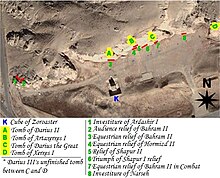
Monuments
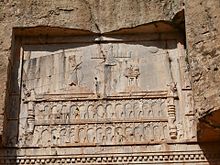
The oldest relief at Naqsh-e Rostam dates back to c. 1000BC. Though it is severely damaged, it depicts a faint image of a man with unusual headgear, and is thought to be Elamite in origin.[3]
Achaemenid tombs
Four tombs belonging to
Tomb of Darius the Great
One of the tombs is explicitly identified, by an accompanying inscription (“parsa parsahya puthra ariya ariyachitra”, meaning, “a Parsi, the son of a Parsi, an Aryan, of Aryan family),
Other tombs
The other three tombs are believed to be those of Xerxes I (c. 486–465 BC), Artaxerxes I (c. 465–424 BC), and Darius II (c. 423–404 BC) respectively. The order of the tombs in Naqsh-e Rostam follows (left to right): Darius II, Artaxerxes I, Darius I, Xerxes I. The matching of the other kings to tombs is somewhat speculative; the relief figures are not intended as individualized portraits.[1]
Darius I inscription
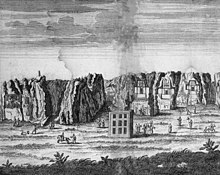
An inscription by
| English translation | Original |
|---|---|
|
  |
DNf inscription. There are various and contradictory reports about how this inscription was discovered. According to Mrs. Khadija Totunchi, she took a photo of this inscription in 2017. But she did not find a suitable person to translate and read the inscription. Also, according to Ebrahim Rustaei, in 2018, in cooperation with Abdul Majid Arfai, he presented an article about the inscription to the International Conference on History and Culture of Southern Iran (Historical Persia), in which a reading of the inscription was presented. However, this reading is very basic and has many flaws. But finally, the DNf petroglyph, which had been hidden in the shade and under algae and sediments for 2500 years, was officially and scientifically recorded by Mojtaba Doroodi and Soheil Delshad in February 2019.[3][12]
Babylonian Transliteration: 1- [mx-x-x(-x) LÚ
pa-id-di-iš-ḫu]-ri-iš ˹a˺-˹na˺ m da-a-ri-i̭a-˹muš˺ LUGAL i-GA-ir-ra-bi
Translation (based on the Babylonian version): [Personal Name, Pati]schorian, invokes blessing upon Darius the King.[13]
Ka'ba-ye Zartosht

Ka'ba-ye Zartosht (meaning the "Cube of Zoroaster") is a 5th-century B.C Achaemenid square tower. The structure is a copy of a sister building at Pasargadae, the "Prison of Solomon" (Zendān-e Solaymān).
Several theories exist regarding the purpose of the Ka'ba-ye Zartosht structure.[14]
Sassanid reliefs
Seven over-life sized rock reliefs at Naqsh-e Rostam depict monarchs of the
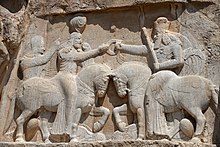
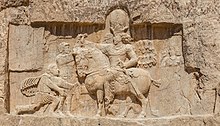
Investiture relief of Ardashir I, c. 226–242
The founder of the
Triumph of Shapur I, c. 241–272)
The most famous of the Sassanid rock reliefs, and depicts the victory of Shapur I over two Roman emperors, Valerian and Philip the Arab. Behind the king stands Kirtir, the mūbadān mūbad ('high priest'), the most powerful of the Zoroastrian Magi during the history of Iran.[15]
In an inscription, Shapur I claims possession of the territory of the
I, the Mazda-worshipping lord, Shapur, king of kings of Iran and An-Iran… (I) am the Master of the Domain of Iran (Ērānšahr) and possess the territory of Persis, Parthian… Hindestan, the Domain of the Kushan up to the limits of Paškabur and up to Kash, Sughd, and Chachestan.
"Grandee" relief of Bahram II, c. 276–293

On each side of the king, who is depicted with an oversized sword, figures face the king.
Two equestrian reliefs of Bahram II, c. 276–293
The first equestrian relief, located immediately below the fourth tomb (perhaps that of Darius II), depicts the king battling a mounted Roman enemy. The second equestrian relief, located immediately below the tomb of Darius I, is divided into two registers, an upper and a lower one. In the upper register, the king appears to be forcing a Roman enemy, probably Roman emperor
-
First equestrian relief.
-
The two-panel equestrian relief.
-
Hormizd I Kushanshah on the lower panel.[17]
Investiture of Narseh, c. 293–303

In this relief, the king is depicted as receiving the ring of kingship from a female figure that is frequently assumed to be the divinity
Equestrian relief of Hormizd II, c 303–309
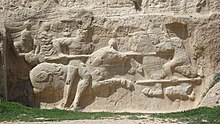
This relief is below tomb 3 (perhaps that of Artaxerxes I) and depicts Hormizd forcing an enemy (perhaps Papak of Armenia) from his horse.
Archaeology

In 1923, the German archaeologist
Naqsh-e Rostam was excavated for several seasons between 1936 and 1939 by a team from the
See also
- Behistun Inscription
- Bishapur
- Essaqwand Rock Tombs
- Istakhr
- Naqsh-e Rajab
- Persepolis
- Qadamgah (ancient site)
- Pasargadae and Tomb of Cyrus the Great
- Taq-e Bostan (rock reliefs of various Sassanid kings)
- Ming and Qing Imperial Tombs – Royal tombs of the Ming and Qing Dynasties.
- Sacred Valley (Peru)
- Burial place of Genghis Khan – An undiscovered place of burial of Genghis Khan and his royal family.
- Valley of the Kings (Egypt)
- Valley of the Kings (Tibet)
- List of colossal sculptures in situ
Notes
- ^ a b Cotterell, 162; Canepa, 57–59, 65–68
- ^ Herrmann and Curtis; Canepa, 62, 65–68
- ^ [1] Morteza KHANIPOOR et al, The reliefs of Naqš-e Rostam and a reflection on a forgotten relief, Iran, Historia i Świat, iss. 6, pp. 55-68, 2017
- ^ "I am Darius".
- ^ Orientalia Lovaniensia Periodica (in French). Instituut voor Oriëntalistiek. 1974. p. 23.
- ISBN 9781575061207.
- ^ Tolman, Herbert Cushing (1893). A guide to the Old Persian inscriptions. New York, Cincinnati [etc.] American book company. p. 146.
 This article incorporates text from this source, which is in the public domain.
This article incorporates text from this source, which is in the public domain.
- ^ "DNa - Livius". www.livius.org.
- ISBN 9780521770200.
- ^ The Achaemenid Empire in South Asia and Recent Excavations in Akra in Northwest Pakistan Peter Magee, Cameron Petrie, Robert Knox, Farid Khan, Ken Thomas p.713-714
- ^ NAQŠ-E ROSTAM – Encyclopaedia Iranica.
- ^ Delshad, Soheil. "کتیبهای در سایه (کتیبه نویافته هخامنشی موسوم به DNf)". ویژه نامه فرهنگستان - زبانها و گویشهای ایرانی. 11: 3–28.
- ^ Delshad, Soheil (5 March 2019). "DNf : A New Inscription Emerges from the Shadow". Arta.
- ^ "Welcome to Encyclopaedia Iranica".
- ^ Rome in the East: The Transformation of an Empire. Warwick Ball. page 120. Psychology Press, 16 Jan 2001.
- ^ a b Rezakhani, Khodadad (2021). "From the Kushans to the Western Turks". King of the Seven Climes: 202–203.
- ^ a b Encyclopedia Iranica HORMOZD KUŠĀNŠĀH article
- ISBN 0-226-62170-7
References
- Canepa, Matthew P., "Topographies of Power, Theorizing the Visual, Spatial and Ritual Contexts of Rock Reliefs in Ancient Iran", in Harmanşah (2014), google books
- Cotterell, Arthur (ed), The Penguin Encyclopedia of Classical Civilizations, 1993, Penguin, ISBN 0670826995
External links
- Ernst Herzfeld Papers, Series 5: Drawings and Maps, Records of Naqsh-i Rustam Archived 2012-02-27 at the Wayback Machine Collections Search Center, S.I.R.I.S., Smithsonian Institution, Washington, D.C.
- Hubertus von Gall "NAQŠ-E ROSTAM" in Encyclopædia Iranica [4]
- Lendering, Jona (2009). "Naqsh-i Rustam". Amsterdam: Livius. Archived from the original on 3 March 2016. Retrieved 26 March 2020.
- Unknown (2005). "Naghsh-e-Rostam".
- Herrmann, G. & Curtis, V. S. (2003). "Sasanian Rock Reliefs". Encyclopedia Iranica. Costa Mesa: Mazda.




![Hormizd I Kushanshah on the lower panel.[17]](http://upload.wikimedia.org/wikipedia/commons/thumb/e/e4/Hormizd_I_Kushanshah_on_the_Naqsh-e_Rustam_Bahram_II_panel.jpg/120px-Hormizd_I_Kushanshah_on_the_Naqsh-e_Rustam_Bahram_II_panel.jpg)
